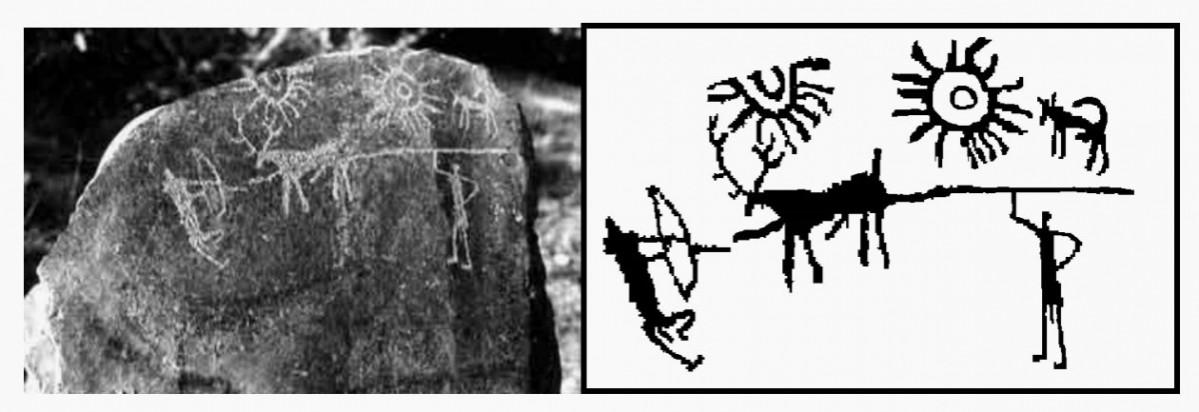![[Representational image] NASA's Chandra X-ray Observatory and the NSF's Jansky Very Large Array captures a supernova G1.9 0.3 in the Milky Way. nasa, supernova, G1.9 0.3, space,](https://data1.ibtimes.co.in/en/full/635913/nasa-supernova-g1-9-0-3-space.jpg?h=450&l=50&t=40)
Researchers claim to have found rock art in Burzahama region in Kashmir, India, that they believe might be the oldest depiction of supernova, an explosion of a star. The rock carving, dating back 5,000 years depicts a sky with two bright objects and a hunting scene.
Also Read: Chameleon Supernova' mystery solved?
A study detailing the discovery of the oldest depiction of the supernova was published in the December issue of the Indian Journal of History of Science. Astrophysicist Mayank Vahia and his colleagues at the Tata Institute of Fundamental Research mentioned in the study that the rock art could be the oldest record of a supernova.
The stone with the carving was found in Kashmir in a rock wall with the stone facing inside the site, which has already been dated back to around 2100 BC. Researchers believe that the importance of the rock art had been lost by then as the stone had been reused to construct another structure. The oldest settlement in Burzahama was found to have a history dating back to around 4100 BC. So, it is assumed that the rock art might have been made sometime between 2100 BC and 4100 BC.
Vahia and his colleagues wanted to know why would someone draw two bright objects and for that they worked to find out if there were any supernovas bright enough to be seen on the Earth during that period.

At first, the art appeared to be part of a hunting scene, but researchers later came to the conclusion that it might represent star patterns and that the two bright object are a sun or moon and a supernova.
"One of the objects is either the Sun or bright Moon and the second object is relatively close to the first. They cannot be Sun and Moon since, with such proximity to the Sun, the Moon would be in a partial phase around the new and hence not very bright," the study said.
After investigating, Vahia discovered that a supernova HB9 had exploded around 3600 BC and the drawings of humans and animals might be representations of constellations. The image of one of the hunters represents Orion, while the one holding a spear is part of Pisces. The deer they are attacking is Taurus and the other animal on the right may be Andromeda and Pegasus.
"We, therefore, investigate the possibility that the rock drawing is the record of the supernova HB9. We suggest that the partially drawn object is HB9 since it would be irregular and that the second bright object is Moon since the apparent magnitude of HB9 is closer to that of the Moon," Vahia said in the study.
"We suggest that this is not a terrestrial hunting scene but is actually a sky-map giving the location of prominent constellations and the Moon on the day the supernova was first observed."
Vahia, who is working with the Indira Gandhi National Centre for the Arts, has also studied many more pieces of rock from the region to find another sky chart. According to Vahia, if ancient people drew one sky chart, then there is a possibility that they drew another. He is confident that more discovery of such artwork from the region will corroborate his discovery.

What is a supernova?
According to NASA, a supernova is the explosion of a star and it burns only for a short period of time. Supernovas are often not visible in our Milky Way galaxy because of dust.
"A supernova happens where there is a change in the core, or center, of a star. A change can occur in two different ways, with both resulting in a supernova," NASA explained.
"The first type of supernova happens in binary star systems. Binary stars are two stars that orbit the same point. One of the stars, a carbon-oxygen white dwarf, steals matter from its companion star. Eventually, the white dwarf accumulates too much matter. Having too much matter causes the star to explode, resulting in a supernova.
"The second type of supernova occurs at the end of a single star's lifetime. As the star runs out of nuclear fuel, some of its mass flows into its core. Eventually, the core is so heavy that it cannot withstand its own gravitational force. The core collapses, which results in the giant explosion of a supernova. The sun is a single star, but it does not have enough mass to become a supernova," NASA explained.

















